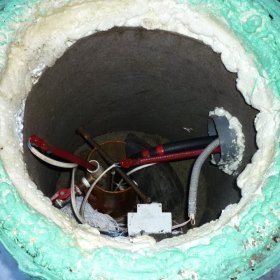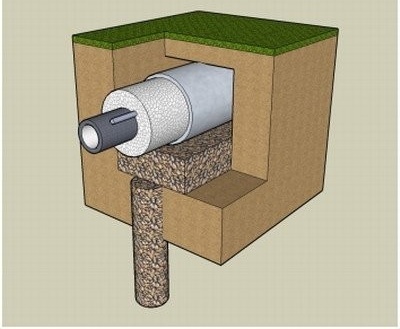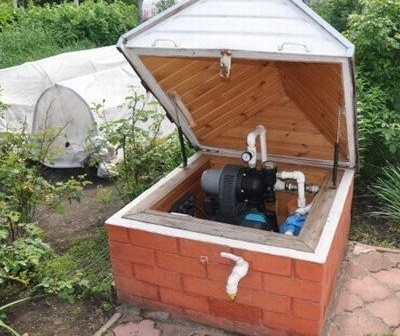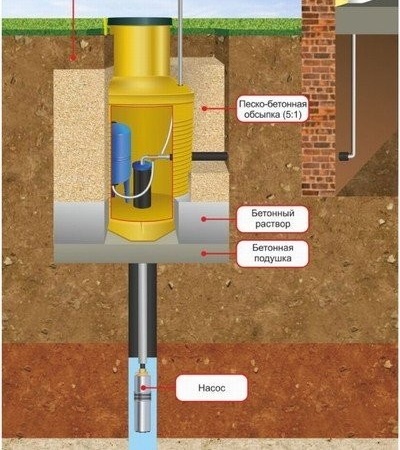How to warm a well: the best ways to save water in the winter

Water supply for most dachas and cottages built outside the city is provided from a well drilled on the site. In the summer, there are no problems with the operation of this source. With the onset of the cold season, there is a risk of freezing of the casing and feed pipe. To prevent the occurrence of interruptions in the water supply, the owner of the house has to think about how and how to warm the well for the winter. You can protect the building from freezing with the help of improvised materials: dry leaves, sawdust, peat, straw or hay. It is more efficient to use for these purposes modern mineral wool insulation used in construction for thermal insulation of structures. The solution to the problem once and for all is made possible by the installation of a caisson - a sealed metal or plastic well, which is closed for the winter with a lid insulated with foam. In any case, work on the insulation of the casing and pipes supplying water to the house must be carried out in advance.
Content
What material and how best to insulate?
The choice of heat-insulating materials is made taking into account the climatic conditions of the area. At the same time, the depth of groundwater at the location of the well plays a role. In regions with mild climates, where the thermometer’s column rarely drops below minus 5-15 degrees, inexpensive natural materials can be dispensed with: sawdust, straw, peat, dry leaves. A box is made around the borehole and the selected material is poured there. Protect the heat insulator from moisture, so as not to reduce its thermal insulation properties.

Peat moss used to warm the borehole is filled into a self-made box made of barrels or pipes of wide diameter
Thermal insulation of industrial production is recommended for use in regions with more severe climates, high groundwater levels, leading to significant freezing of the soil in the complex. Materials are selected taking into account the technical characteristics and cost per square meter. You can stay on polystyrene, basalt wool, penoizol, glass wool, polystyrene. These heaters are also used in preparation for winter operation of wells equipped with electric pumps.
It is known from the school physics course that air has the worst thermal conductivity. Therefore, it is recommended to leave an air gap of 5 cm thick between the casing and the insulation layer. This air gap will additionally protect the well from freezing. By the way, in modern heaters this property of air is used.Foamed materials include the smallest air bubbles, which increase their thermal insulation qualities. The thickness of the insulation layer should be at least 30-35 cm.

The well, which is actively used in the summer for watering the garden and watering a private house, needs winterizing with improvised materials
Work on the insulation of a water well is usually carried out in the following order:
- sheathe the riser with a fine-mesh metal mesh, retreating from its walls by a distance equal to 5 cm;
- then put on the design a metal casing, leaving between him and the grid the necessary space for the placement of insulation;
- backfill of sawdust or other material selected for the insulation of the well (fill material is not rammed);
- install a tin tray under the valve, extending beyond the metal casing, maintaining a slight slope to prevent moisture from entering the insulation.
For safety, you can carry out insulation using an additional heating system. A small heater is installed in the well, as well as a floating freezing sensor. When a thin ice crust forms on the surface of the water in the well, the sensor is triggered and the heater is turned on, which helps melt the ice. With this arrangement of the well, it is possible to protect it from freezing, reducing energy costs.
Insulation of the eyeliner to the house - pipe in pipe
It is possible to reduce the amount of excavation work when laying the route from the well to the house using horizontally directed drilling, as well as soil puncture technology. A water pipe is placed in a “case”, the role of which is played by a pipe of a larger diameter. The pipe, together with the cable that feeds the pump, is placed in heat-insulating cylinders manufactured by manufacturers of mineral wool or foam plastic insulation. If necessary, the damaged pipe is easily pulled out of the “case” and replaced. To facilitate the process of removing the pipe from the protective casing, you can use a cable.

The laying of the insulated pipeline from the well to the house is carried out according to the “pipe in pipe” principle. This protects the feed pipe from freezing.
Emergency option - boiling water resuscitation
If extreme frosts or power outages caused the well to freeze, then you can try to revive it with boiling water. To melt the ice plug in the well, you need to take a metal pipe with a diameter of 10 mm. Then put a rubber hose on this tube, connecting a funnel to it. The tube is lowered into the well until it stops in an ice plug. Then they begin to pour boiling water into the funnel. Under the influence of hot water, the ice will gradually melt, and the tube will go down smoothly. After a few minutes, it will be possible to clear the well of the formed ice.
In the case when the well is in order, and the water does not enter the house due to the frozen pipes coming from the pump, then a decision is made to replace them. If the walls of the water supply did not crack under the action of frozen water, then you can try to enter the heating wire directly into the pipe using a special device. In this case, a cable is selected that can be used in water supply systems.
Installation of the insulated box
In regions with a mild climate and insignificant frosts, it is not necessary to install a caisson. The head of the well, together with all the equipment, is placed in an insulated box, which is opened if necessary. The protective structure can be built of wooden building materials or laid out of brick. On the inner side of the wall are covered with insulating material. In addition to warming, such a design can also perform a decorative function, if original design ideas are introduced into its design.

Well insulation in regions with a warm climate is carried out by building a small house in which equipment and pipe wiring are hidden
Plastic caisson as the best way to warm
If arranged well head and the entire wiring of pipes below the level of freezing soil, then you do not have to worry about their insulation. At this depth, even in the most severe frosts, water will not freeze in the well, as its temperature will be constantly above zero. To achieve this goal, you have to dig a pit around the borehole to a depth of 2-2.5 meters and install a caisson. For one hundred percent reliability, the walls of the caisson and the cover of its hatch are insulated with mineral wool or foam.

Well insulation using a plastic caisson installed in a dug pit around the casing to a depth of 2.5 meters
At extremely low temperatures in the caisson well, it is recommended to install an additional cover with a heater directly above the well to prevent the possibility of freezing of water in the pipes. Installation of this element is carried out in advance, since it is undesirable to open the hatch in severe frosts.
Insulate or repair: which is more profitable?
When deciding on the need to warm the well, remember the proverb about sleds that need to be prepared in the summer. Therefore, do not delay the beginning of the completion of the well until late autumn, when the earth is already frozen in hard frost. Do it yourself in the warm season, spending a minimum amount of money. remember, that repair of equipmentthat crashes due to freezing water can be much more expensive than the purchase of insulation or caisson. You can’t cope with the work yourself, invite specialists who, during the inspection, will tell you how to warm the well in the best way.



3 comments